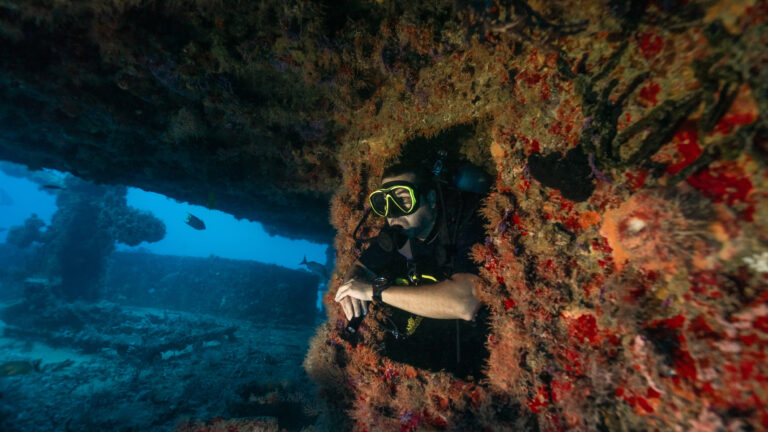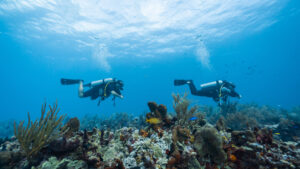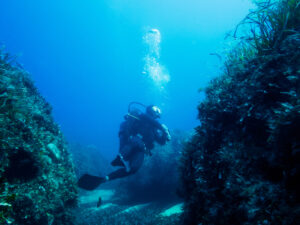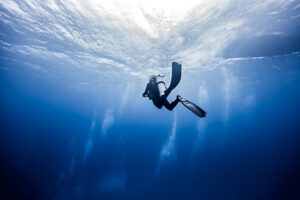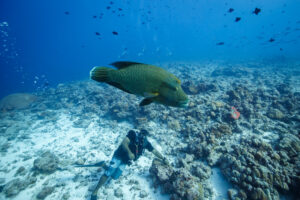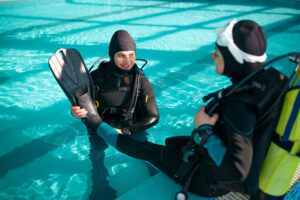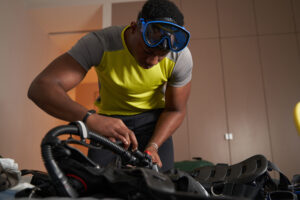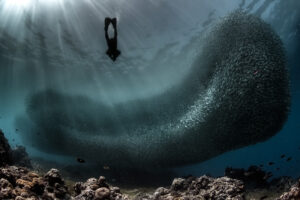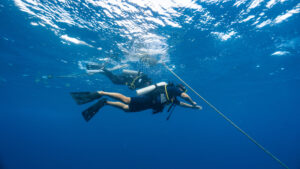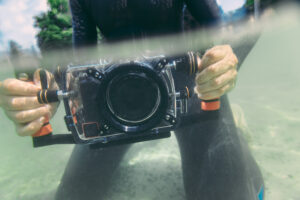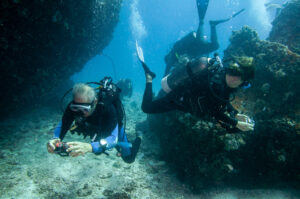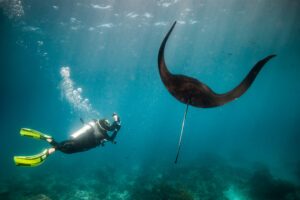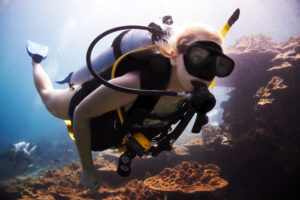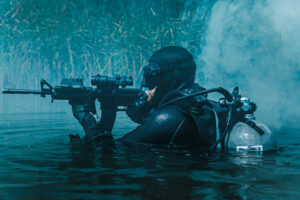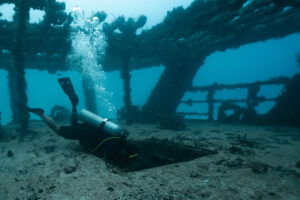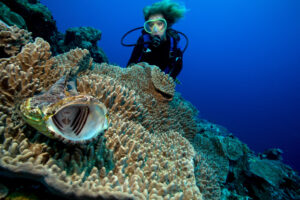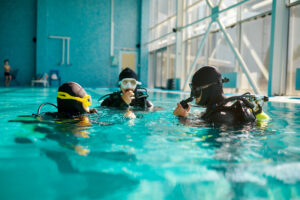What is the Maximum Operating Depth?
Maximum Operating Depth (MOD) is a critical concept in the field of scuba diving. It refers to the deepest depth at which a particular gas mixture can be used safely without the diver experiencing oxygen toxicity. Understanding and adhering to the MOD is essential for ensuring diver safety and preventing potentially life-threatening conditions. MOD varies depending on the gas mixture being used and is influenced by the partial pressure of oxygen within the breathing gas. By comprehending the significance of MOD, divers can plan their underwater excursions more effectively and reduce the risks associated with diving to greater depths.
Definition and Explanation of Maximum Operating Depth
Maximum Operating Depth is defined as the maximum depth at which a given breathing gas can be used without risking oxygen toxicity. Oxygen toxicity occurs when the partial pressure of oxygen in the breathing gas exceeds safe limits, leading to harmful physiological effects. The MOD is calculated using the formula:
[ MOD = \left( \frac{P_{O_2} – 1 \text{ atm}}{F_{O_2}} \right) \times 10 ]
where ( P_{O_2} ) is the maximum safe partial pressure of oxygen (typically 1.4 atm for recreational diving), and ( F_{O_2} ) is the fraction of oxygen in the gas mixture.
Various factors influence the MOD, including the composition of the breathing gas, the depth of the dive, and individual diver physiology. For example, a gas mixture with a higher percentage of oxygen will have a shallower MOD compared to a gas mixture with a lower percentage of oxygen. Divers must take these factors into account when planning their dives to ensure they remain within safe limits.
The concept of MOD is not only essential for preventing oxygen toxicity but also for managing nitrogen narcosis and decompression sickness. By adhering to the calculated MOD, divers can avoid exceeding the safe partial pressure of oxygen, thereby minimizing the risk of these conditions. Understanding the nuances of MOD allows divers to make informed decisions about their dive profiles and gas mixtures, enhancing both safety and enjoyment.
Historical Context
The concept of Maximum Operating Depth has evolved significantly over the years, paralleling advancements in diving technology and safety standards. In the early days of scuba diving, knowledge about gas mixtures and their effects on the human body was limited. Divers often relied on air as their primary breathing gas, which restricted their depth and duration underwater.
As diving technology progressed, so did the understanding of the physiological impacts of different gas mixtures. The introduction of mixed-gas diving, including the use of nitrox and trimix, necessitated a deeper comprehension of MOD. Researchers and pioneers in the field conducted extensive studies to determine safe limits for various gas mixtures, leading to the development of modern MOD guidelines.
Notable figures in the history of diving, such as Jacques Cousteau and Robert H. Davis, made significant contributions to the understanding of MOD. Their research and innovations laid the foundation for current diving practices and safety standards. The development of dive tables and dive computers further revolutionized the way divers calculate and adhere to MOD, providing more accurate and reliable information for planning dives.
Historical incidents, such as the tragic deaths of divers due to oxygen toxicity, underscored the importance of adhering to MOD guidelines. These events prompted the diving community to prioritize safety and develop more comprehensive training programs to educate divers about the risks and proper management of gas mixtures. The evolution of MOD concepts reflects the ongoing commitment to enhancing diver safety and expanding the boundaries of underwater exploration.
Importance of MOD in Scuba Diving
The significance of Maximum Operating Depth in scuba diving cannot be overstated. It plays a crucial role in ensuring diver safety and preventing potentially life-threatening conditions such as oxygen toxicity. By adhering to the MOD, divers can minimize the risks associated with high partial pressures of oxygen and enjoy their underwater experiences without compromising their health.
MOD is a key factor in dive planning and execution. Before embarking on a dive, divers must calculate the MOD for their chosen gas mixture and ensure they do not exceed this depth during the dive. This requires careful consideration of factors such as the composition of the breathing gas, the planned depth and duration of the dive, and individual diver physiology. By taking these variables into account, divers can create a safe and effective dive plan that maximizes their enjoyment while minimizing risks.
Comparing MOD with other depth limits, such as the maximum depth limit and no-decompression limit, highlights its unique importance. While the maximum depth limit refers to the deepest depth a diver can safely reach, and the no-decompression limit indicates the maximum time a diver can spend at a certain depth without requiring decompression stops, MOD specifically addresses the safe use of breathing gases. Understanding and adhering to MOD ensures that divers remain within safe oxygen exposure limits, thereby preventing oxygen toxicity and other related conditions.
The impact of MOD extends beyond individual dives. It influences the selection of gas mixtures, dive profiles, and safety protocols for divers at all levels of experience. For instance, recreational divers often use nitrox, a gas mixture with a higher percentage of oxygen than air, to extend their bottom time and reduce nitrogen absorption. However, the higher oxygen content necessitates a shallower MOD, which divers must respect to avoid oxygen toxicity. By understanding the relationship between gas mixtures and MOD, divers can make informed choices that enhance their safety and enjoyment underwater.
Gas Mixtures and Their Impact on MOD
The type of gas mixture used in scuba diving has a significant impact on the Maximum Operating Depth. Common gas mixtures include air, nitrox, and trimix, each with its unique properties and effects on MOD. Understanding these differences is essential for divers to make informed decisions about their gas mixtures and dive profiles.
Air, composed of approximately 21% oxygen and 79% nitrogen, is the most commonly used gas mixture in recreational diving. The MOD for air is relatively deep compared to other gas mixtures, allowing divers to reach greater depths. However, the higher nitrogen content increases the risk of nitrogen narcosis and decompression sickness, necessitating careful dive planning and adherence to no-decompression limits.
Nitrox, a mixture of oxygen and nitrogen with a higher oxygen percentage than air, is popular among recreational divers for its benefits in reducing nitrogen absorption and extending bottom time. However, the increased oxygen content results in a shallower MOD. For example, a nitrox mixture with 32% oxygen has an MOD of approximately 33 meters (108 feet), compared to the MOD of 56 meters (184 feet) for air. Divers using nitrox must be vigilant in monitoring their depth to avoid exceeding the MOD and risking oxygen toxicity.
Trimix, a mixture of oxygen, nitrogen, and helium, is commonly used in technical diving to reach greater depths while minimizing the risks of oxygen toxicity and nitrogen narcosis. The inclusion of helium reduces the partial pressures of oxygen and nitrogen, allowing for a deeper MOD. For instance, a trimix blend with 18% oxygen, 35% helium, and 47% nitrogen can have an MOD of around 70 meters (230 feet). The use of trimix requires advanced training and certification, as managing the different gas components and their effects on the body is more complex than with air or nitrox.
Each gas mixture presents unique advantages and risks that divers must consider when planning their dives. The choice of gas mixture depends on factors such as the planned depth and duration of the dive, individual diver physiology, and specific dive objectives. By understanding the impact of different gas mixtures on MOD, divers can make informed decisions that enhance their safety and optimize their underwater experiences.
Calculation and Adjustment of MOD
Calculating the Maximum Operating Depth is a crucial skill for divers, as it ensures they stay within safe limits and avoid the risks associated with oxygen toxicity. The calculation involves determining the maximum safe partial pressure of oxygen and the fraction of oxygen in the breathing gas. The formula for calculating MOD is:
[ MOD = \left( \frac{P_{O_2} – 1 \text{ atm}}{F_{O_2}} \right) \times 10 ]
where ( P_{O_2} ) is the maximum safe partial pressure of oxygen, typically 1.4 atm for recreational diving, and ( F_{O_2} ) is the fraction of oxygen in the gas mixture.
To illustrate, consider a nitrox mixture with 32% oxygen. Using the formula, the MOD is calculated as follows:
[ MOD = \left( \frac{1.4 \text{ atm} – 1 \text{ atm}}{0.32} \right) \times 10 \approx 12.5 \text{ meters} ]
This calculation indicates that the maximum safe depth for using this nitrox mixture is approximately 12.5 meters (41 feet).
Dive tables and dive computers are invaluable tools for determining MOD and other critical dive parameters. Dive tables provide a reference for various gas mixtures and depths, allowing divers to plan their dives and ensure they remain within safe limits. Dive computers, on the other hand, offer real-time monitoring of depth, time, and gas mixtures, providing divers with continuous updates and alerts to help them stay within their MOD.
Environmental factors, such as water temperature and altitude, can affect the MOD and must be considered when planning a dive. Cold water can increase the risk of oxygen toxicity, necessitating a more conservative MOD. Similarly, diving at high altitudes reduces atmospheric pressure, which can alter the partial pressure of gases and affect the MOD. Divers must adjust their calculations and dive plans accordingly to account for these variables and ensure their safety.
By mastering the calculation and adjustment of MOD, divers can make informed decisions about their dive profiles and gas mixtures. This knowledge empowers them to explore underwater environments safely and confidently, maximizing their enjoyment while minimizing risks.
Equipment and Technology Related to MOD
Diving equipment and technology play a crucial role in supporting divers within the limits of their Maximum Operating Depth. The proper selection, maintenance, and use of diving gear are essential for ensuring safety and enhancing the overall diving experience.
One of the most important pieces of equipment related to
MOD is the dive computer. Dive computers continuously monitor depth, time, and gas mixtures, providing real-time data to help divers stay within their MOD and other safety limits. Modern dive computers are equipped with advanced algorithms that account for multiple gas mixtures, decompression stops, and ascent rates, offering a comprehensive tool for dive planning and execution.
Scuba tanks and regulators are also critical components of diving gear that influence MOD. The choice of gas mixture in the scuba tank determines the MOD, and the regulator must be capable of delivering the appropriate gas mixture at varying depths. Divers using nitrox or trimix must ensure their regulators are compatible with these gases and regularly maintained to prevent malfunctions that could lead to oxygen toxicity or other hazards.
Buoyancy control devices (BCDs) and dive weights are essential for maintaining proper buoyancy and trim, which are crucial for safe diving within MOD limits. Proper buoyancy control allows divers to maintain a stable position in the water, reducing exertion and gas consumption. This is particularly important when diving near the MOD, as it helps prevent accidental descents that could exceed safe oxygen exposure limits.
Innovations in diving technology have significantly enhanced safety and expanded the possibilities for diving within MOD limits. Closed-circuit rebreathers (CCRs) are a prime example of such advancements. CCRs recycle exhaled gas by removing carbon dioxide and adding oxygen, allowing for longer dive times and more efficient use of gas mixtures. By precisely controlling the partial pressure of oxygen, CCRs enable divers to safely explore deeper environments while managing their MOD.
The importance of maintaining and regularly testing diving equipment cannot be overstated. Regular maintenance ensures that all gear functions properly and reduces the risk of equipment-related incidents. Divers should follow manufacturer guidelines for maintenance and seek professional servicing for complex equipment like regulators and rebreathers. By prioritizing the upkeep of their gear, divers can enhance their safety and confidence when diving within their MOD.
Training and Certification
Proper training and certification are essential for divers to understand and safely manage their Maximum Operating Depth. Various training programs and certification agencies, such as PADI, NAUI, and SSI, offer courses that cover MOD concepts, gas mixtures, and safe diving practices.
Basic scuba certification courses introduce divers to the fundamentals of dive planning, including the calculation of MOD for air. These courses emphasize the importance of adhering to MOD limits to prevent oxygen toxicity and other diving-related risks. Divers learn how to use dive tables and dive computers to plan their dives and monitor their depth and gas consumption in real-time.
Advanced training programs, such as Nitrox Diver and Technical Diver courses, delve deeper into the principles of gas mixtures and their impact on MOD. In a Nitrox Diver course, for example, divers learn how to calculate MOD for different nitrox blends and adjust their dive plans accordingly. These courses also cover the benefits and risks of using nitrox, as well as proper gas analysis and equipment maintenance.
Technical diving courses provide more extensive training on the use of mixed gases like trimix and the management of complex dive profiles. These courses teach divers how to calculate MOD for multiple gas mixtures, plan decompression stops, and handle emergency situations. Technical divers are trained to use advanced equipment, such as closed-circuit rebreathers, and to conduct dives that exceed the limits of recreational diving.
Continuous education and training are vital for divers to stay updated on the latest safety standards and best practices. Diving organizations frequently update their training materials and guidelines based on new research and technological advancements. By participating in refresher courses and specialty training, divers can enhance their skills and knowledge, ensuring they remain competent and confident in their ability to manage MOD and other critical aspects of diving.
Certification for different depths and gas mixtures is a testament to a diver’s competence and readiness to handle the challenges of diving within MOD limits. These certifications are recognized internationally and provide divers with the credentials needed to participate in various diving activities. By obtaining the appropriate certifications, divers demonstrate their commitment to safety and their preparedness to explore underwater environments responsibly.
Safety Considerations
Safety considerations are paramount when managing Maximum Operating Depth in scuba diving. Exceeding the MOD can lead to serious and potentially life-threatening conditions, such as oxygen toxicity. Understanding the risks and implementing preventive measures is crucial for ensuring safe diving practices.
Oxygen toxicity is a primary concern when diving beyond the MOD. It occurs when the partial pressure of oxygen in the breathing gas exceeds safe limits, leading to harmful effects on the central nervous system and pulmonary system. Symptoms of oxygen toxicity include visual disturbances, nausea, twitching, irritability, and in severe cases, convulsions and loss of consciousness. These symptoms can be exacerbated by factors such as cold water, physical exertion, and prolonged exposure to high oxygen levels.
To prevent oxygen toxicity, divers must adhere to their calculated MOD and monitor their depth and gas consumption closely. Using dive computers and following dive plans that account for MOD limits are effective strategies for staying within safe limits. Divers should also be aware of the signs and symptoms of oxygen toxicity and know how to respond in case of an emergency.
Proper gas analysis and equipment maintenance are critical for ensuring the safety of divers operating within MOD limits. Divers must analyze their gas mixtures before each dive to confirm the oxygen content and calculate the appropriate MOD. Regular maintenance of diving equipment, especially regulators and rebreathers, helps prevent malfunctions that could lead to accidental exposure to high oxygen levels.
Buddy diving is an important safety practice that enhances the ability to manage emergencies related to MOD. Diving with a buddy provides an additional layer of safety, as buddies can assist each other in monitoring depth and gas consumption, recognizing symptoms of oxygen toxicity, and responding to emergencies. Effective communication and pre-dive planning with a buddy ensure that both divers are aware of each other’s MOD and are prepared to handle any issues that may arise.
Safety protocols, such as conducting pre-dive safety checks and following established ascent rates, further reduce the risk of incidents related to MOD. Pre-dive safety checks ensure that all equipment is functioning properly and that gas mixtures are correctly analyzed. Controlled ascent rates and safety stops help prevent decompression sickness and allow divers to safely manage their gas consumption and exposure to high oxygen levels.
By prioritizing safety considerations and adhering to MOD guidelines, divers can minimize the risks associated with high partial pressures of oxygen and enjoy their underwater experiences with confidence and peace of mind.
Case Studies and Real-Life Examples
Examining case studies and real-life examples provides valuable insights into the practical application of Maximum Operating Depth and the importance of adhering to safety guidelines. These examples illustrate both successful dives within MOD limits and the consequences of exceeding safe oxygen exposure levels.
One notable example of successful diving within MOD limits involves a group of recreational divers using nitrox for a series of dives on a coral reef. The divers calculated the MOD for their nitrox mixture, which contained 32% oxygen, and planned their dives accordingly. By adhering to the calculated MOD of 33 meters (108 feet), the divers were able to enjoy extended bottom times and reduced nitrogen absorption, enhancing their overall diving experience. Their adherence to MOD guidelines ensured that they remained safe and avoided any symptoms of oxygen toxicity.
In contrast, a tragic incident occurred when a technical diver exceeded the MOD for a trimix blend during a deep wreck dive. The diver was using a trimix mixture with 18% oxygen, which had an MOD of approximately 70 meters (230 feet). However, due to a combination of equipment malfunction and poor visibility, the diver inadvertently descended beyond the MOD, reaching a depth of 80 meters (262 feet). The increased partial pressure of oxygen led to severe oxygen toxicity, resulting in convulsions and ultimately, the diver’s death. This incident underscores the critical importance of adhering to MOD limits and maintaining situational awareness during dives.
Another example highlights the importance of proper gas analysis and equipment maintenance. A group of divers planned a series of dives using nitrox, but one diver failed to properly analyze their gas mixture before the dive. As a result, the diver’s tank contained a higher percentage of oxygen than expected, leading to a shallower MOD. During the dive, the diver exceeded the calculated MOD, experiencing mild symptoms of oxygen toxicity. Fortunately, the diver recognized the symptoms early, ascended to a shallower depth, and ended the dive safely. This incident emphasizes the necessity of thorough gas analysis and equipment checks to ensure safe diving practices.
Real-life examples also demonstrate the effectiveness of buddy diving in managing emergencies related to MOD. In one instance, a diver using nitrox began to exhibit symptoms of oxygen toxicity during a dive. The diver’s buddy recognized the symptoms, assisted in a controlled ascent to a shallower depth, and provided support throughout the ascent and surface procedures. The prompt response and effective communication between the buddies prevented a potentially life-threatening situation and highlighted the importance of diving with a buddy and maintaining vigilance for each other’s safety.
These case studies and examples serve as powerful reminders of the importance of adhering to MOD guidelines, conducting proper gas analysis, maintaining equipment, and diving with a buddy. By learning from these real-life scenarios, divers can better appreciate the critical role of MOD in ensuring safe and enjoyable underwater experiences.
Key Takeaways
Understanding and adhering to the Maximum Operating Depth is essential for safe and enjoyable scuba diving. By calculating and respecting MOD limits, divers can prevent oxygen toxicity and other related risks. Proper training, equipment maintenance, and adherence to safety protocols are crucial for managing MOD effectively. Real-life examples underscore the importance of these practices, highlighting both successful dives and the consequences of exceeding MOD limits. Respecting MOD ensures diver safety and enhances the overall underwater experience.

